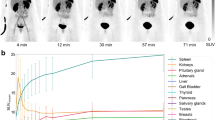Abstract.
In a pilot study, DOTA-d-Phe1-Tyr3-octreotide (DOTATOC), which can be labelled with the β-emitting radioisotope yttrium-90, has recently been used for the treatment of patients with advanced somatostatin receptor-positive tumours who had no other treatment option. The aim of the present study was to elucidate the therapeutic potential of 90Y-DOTATOC in a larger number of patients employing a standardized treatment protocol. Careful attention was paid to any side-effects (renal and/or haematological toxicity). Of 44 patients with advanced somatostatin receptor-positive tumours of different histology, 29 could be included in the study. The 15 patients who were excluded from the study protocol were assigned to our institution for purely compassionate reasons. The 29 patients who were included received four or more single doses of 90Y-DOTATOC with ascending activity at intervals of approximately 6 weeks (cumulative dose 6120±1347 MBq/m2) with the aim of performing an intra-patient dose escalation study. In total, 127 single treatments were given. In eight of these 127 single treatments, total doses of ≥3700 MBq were administered. In an effort to prevent renal toxicity, two patients received Hartmann-Hepa 8% solution during all therapy cycles, while 13 patients did so during some but not all therapy cycles; in 14 patients no solution was administered during the therapy cycles. The treatment was monitored by computed tomography and indium-111 DOTATOC scintigraphy. Blood parameters were controlled weekly, while tumour markers and liver enzymes were controlled 6-weekly. Of the 29 patients, 24 patients showed no severe renal or haematological toxicity (toxicity ≤ grade 2 according to the National Cancer Institute grading criteria). These 24 patients received a cumulative dose of ≤7400 MBq/m2. Five patients developed renal and/or haematological toxicity. All of these five patients received a cumulative dose of >7400 MBq/m2 and had received no Hartmann-Hepa 8% solution during the therapy cycles. Four of the five patients developed renal toxicity; two of these patients showed stable renal insufficiency and two require haemodialysis. Two of the five patients exhibited anaemia (both grade 3) and thrombopenia (grade 2 and 4, respectively). To date, 20 of the 29 patients have shown a disease stabilization, two a partial remission, four a reduction of tumour mass <50% and three a progression of tumour growth. 90Y-DOTATOC could be a powerful and promising new therapeutic agent for anti-cancer treatment – at least in terms of an adjuvant starting point of the disease. However, problems with toxicity have to be solved. Evaluation of the effect of amino acid infusions (e.g. Hartmann-Hepa 8% solution) during 90Y-DOTATOC treatments with the aim of reducing renal toxicity is ongoing.
Similar content being viewed by others
Author information
Authors and Affiliations
Additional information
Received 12 February and in revised form 16 May 1999
Rights and permissions
About this article
Cite this article
Otte, A., Herrmann, R., Heppeler, A. et al. Yttrium-90 DOTATOC: first clinical results. Eur J Nucl Med 26, 1439–1447 (1999). https://doi.org/10.1007/s002590050476
Issue Date:
DOI: https://doi.org/10.1007/s002590050476




